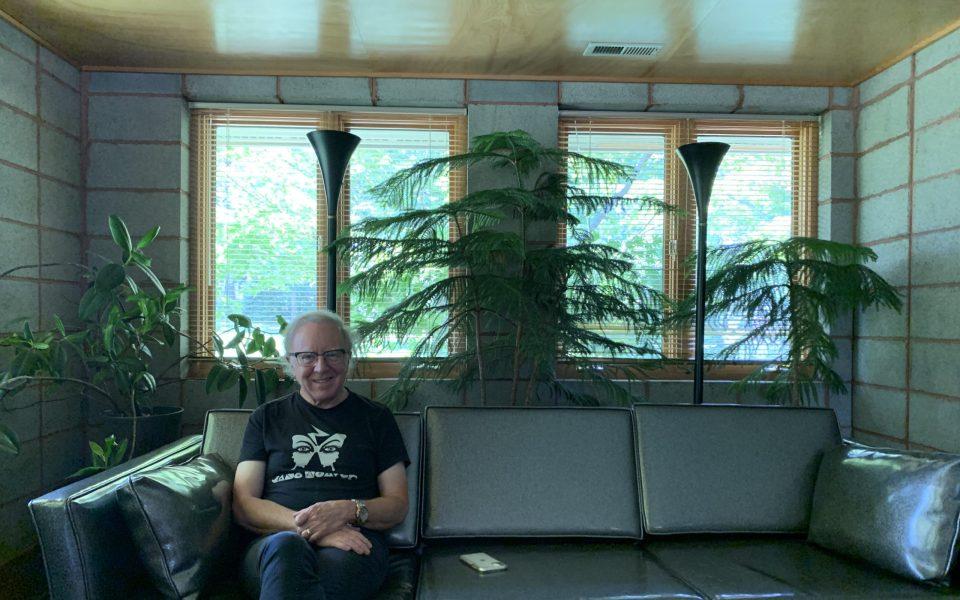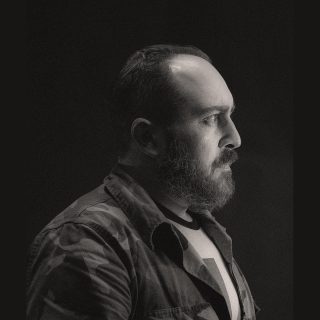Photos by Jerry Cooper
The studio sits at the end of a nondescript gravel road off the highway. Inside, the feel is vaguely ’70s with a modern façade, almost timeless, not set by any particular era or influence.
The owner gives a short tour: The pristine reel to reels, vintage microphones and digital recording equipment are placed around the various rooms. They are functional art pieces, ready to be utilized when needed. The cathedral-like main studio is built to foster inspiration when it hits. The place feels like an empty church, quietly waiting for its congregants to show up and, if so moved, speak in their chosen tongues.
In a way, it is.

a stocked kitchen, multiple lounge areas, a guest house
Musician, producer and studio head Mitch Easter isn’t the type to talk up his accomplishments. Non-imposing, he moves with an ease as he gives a tour of the Fidelitorium, the stylish, yet accessible studio he built in his backyard in Kernersville.
“I started the studio in 1980, and I was lucky to immediately record some things that… did something,” he says as he sits in a sunroom adjacent to the studio. Because of the general isolation, the Fidelitorium has amenities to ensure that the artists can take breaks while recording: a stocked kitchen, multiple lounge areas, a guest house.
One of those “things” Easter produced was REM’s first single “Radio Free Europe,” which put the band on the map. Easter later produced their first EP, co-produced their first two albums and started Let’s Active, a Winston-Salem based band that included Easter, Faye Hunter and Sara Romweber. With catchy songs, an off-pop look, and killer instrumentation, they contributed to the early ’80s heyday of post-punk, new-wave indie pop. This style included the B-52’s, REM and Oingo Bongo, among others.
His career, which spans numerous decades, venues, artists and self-made studios, is indication enough of his bona fides while the reams of music knowledge contained within his mind offer hours of discussion for music nerds.
Easter is a native of Winston-Salem, starting Drive-In Studios, a small studio in a garage at 4527 Old Belews Creek Road, close to downtown Winston-Salem, upon moving back from New York City in 1980.
“Nothing was really happening here exactly, but in a bigger sense, things were,” he says. “College radio was happening and my studio business kind of fed into that scene.”

Pre-internet, and around the advent of MTV, new music was shared via college radio and picked up by independent labels, he explains. It was a way to market to younger audiences and easier to get popular airplay. His choice to operate in a small college town proved fortuitous; It allowed him to produce and record other regional bands and start his own.
“It was the first band that was like, my band,” Easter says. “I kind of had to start from scratch. Faye was my girlfriend from when I was a teen, and she was a natural. She had started playing bass and was like, instantly good. And then it was, ‘Well, we just need drums, you know?’”
Enter Sara Romweber, a 17-year-old drummer from Chapel Hill who was playing with a ska band.
“We had to pester her to join us because she was in this band with her boyfriend…. She did eventually cave in,” Easter says with a chuckle. “She was great, she really was.”
Like REM, Let’s Active was picked up by IRS Records, an independent label that also repped bands like the Go-Gos, the Cramps, Gary Numan and the Bangles in the early ’80s. From there, it led to touring, albums, and inclusion in the MTV avalanche that launched a new medium.
“The philosophy of IRS was sort of cool,” Easter says. “You could almost say ‘crass,’ or even ‘smart,’ of just messing around with these little bands that had a punk sensibility and being like, ‘We’ll give you a little bit of money to make an album,’ which sort of fit the times.”
Let’s Active’s first EP, Afoot, was released in 1983 and immediately made the rounds on college radio. They filmed the single “Every Word Means No” from that album for MTV’s “IRS Presents: The Cutting Edge” show, which later evolved into “120 Minutes,” MTV’s late-night showcase of indie music which provided an alternative to their equally popular “Headbanger’s Ball.”
The band’s full-length album Cypress was released in 1984. It was the last album to feature both Faye Hunter and Sara Romweber, who passed away in 2013 and 2019, respectively.
When asked if he could have done Let’s Active with anyone else, he pauses for a moment. “I think the vibe of those two were absolutely critical to us getting anywhere…,” he says. “Not only were they good, but the whole weird smurfy look we had, and the fact that a lot more women were in bands all of a sudden, I was really happy to be part of that vibe. I wasn’t really a scary punk guy, and the kind of odd pop music we played was really great. It was fun. It was fun to do that.”
Easter went on to record two more albums as Let’s Active and has stayed busy as a musician in the years since.
More often these days, Easter still records, produces and mixes various artists in his the Fidelitorium. It has hosted such artists as Ben Folds, the Avett Brothers, Joe Walsh, Yusef Islam (formerly Cat Stevens), Wilco, Between the Buried and Me and many others. He has remained busy mixing during the COVID-19 shutdown, even though they were closed to recording sessions.
“I’m rusty,” he says with a hint of sarcasm.
Mitch Easter will perform at the Let’s Active 40th Anniversary Event with guest artists, commentary and tributes to original bandmembers Faye Hunter and Sara Romweber on Nov. 4th at the Ramkat, 170 W. 9th St. in Winston-Salem. It’s being produced by MUSE Winston-Salem. Tickets are available here
Join the First Amendment Society, a membership that goes directly to funding TCB‘s newsroom.
We believe that reporting can save the world.
The TCB First Amendment Society recognizes the vital role of a free, unfettered press with a bundling of local experiences designed to build community, and unique engagements with our newsroom that will help you understand, and shape, local journalism’s critical role in uplifting the people in our cities.
All revenue goes directly into the newsroom as reporters’ salaries and freelance commissions.


Drive-In Studios was not at Shady Blvd. It was in his parents garage on Belews Creek Road.